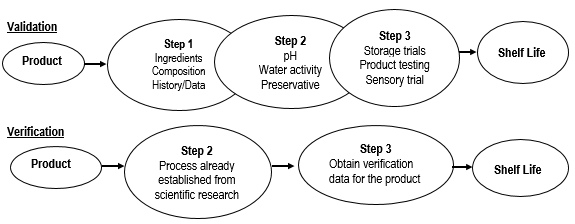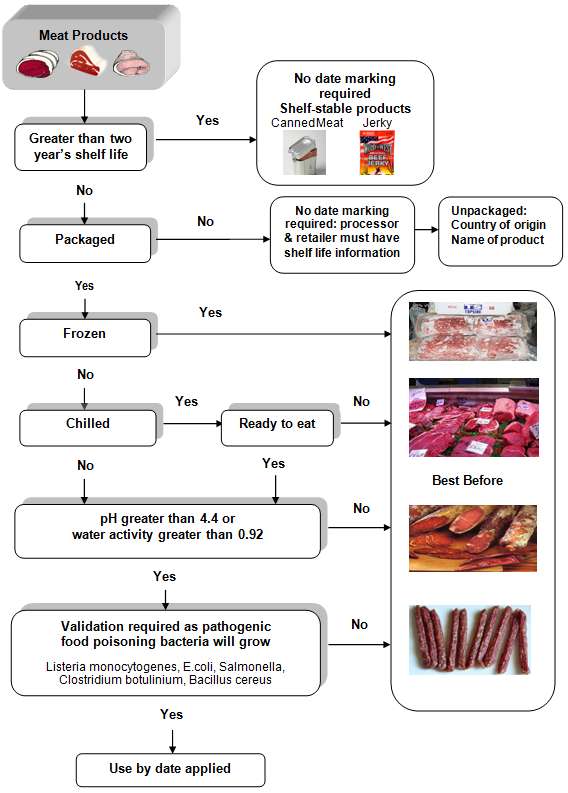Shelf Life and Labelling PrimeSafe Technical Guideline
This technical guideline outlines the shelf life and labelling rules for meat products.
Summary
- This is a guideline only. Be sure to understand the standards referred to by this guideline.
- Learn how meat products in Australia are processed, packaged, and labelled to provide a maximum and safe shelf life.
- This guideline does not apply to seafood.
- The mandatory requirements for labelling and date marking are explained.
In Australia, meat is processed, packaged and labelled to obtain the maximum shelf life without creating a food safety risk to consumers. Meat products can be generally classified into the categories of unprocessed and processed. Unprocessed fresh meat can be sold as either chilled or frozen. Meat that has been processed by heating, curing or drying can be sold as shelf stable, chilled or frozen, depending on customer requirements. Shelf life of any of these products depends on the processes applied and temperature control along the supply chain.
Shelf life
The shelf life of products is generally determined by conducting storage trials under the conditions that the product would be sold (e.g. ambient, chilled or frozen). Usually the shelf life is determined in the product development stage by skilled technologists or processors that know the product well. In most cases variables such as pH, water activity, preservative content and storage temperatures are considered when decisions are made on the life of the product.
In some instances, shelf life is estimated based on the history of the product and its composition. Figure 1 explains the process used to make a decision on shelf life. Table 1 summarises shelf life guidelines for meat products stored frozen or up to 5°C. The reference temperature of 5°C included in the table is the minimum standard required by the Standard AS 4696. Lower temperatures may achieve a greater shelf life for processed products, however this requires scientific validation or other evidence from a credible source.
Validation data from product specific trials and testing must be provided for any situation outside these guidelines. If process is adopted from scientific research, then verification records must be provided for the shelf life values used as shown in shown in Figure 1.

Labelling
The Australia New Zealand Food Standards Code (the Code) requires that food businesses provide critical information for consumers so they have knowledge of the products they purchase. A labelling declaration is mandatory in Australia and the Code prescribes a minimum standard for the necessary information for meat products. Each Licensee’s food safety program must contain procedures and data collected to allow validation and verification of any statements or claims made on a product label. The following highlights some of the labelling information required by the Code:
- Name of the product – to describe the nature of the food
- Legibility – in clear English, text must be minimum 3mm high for large packages and 1.5mm for small packages
- Date marking – best before and use by date for foods that have a shelf life of less than 2 years
- Name and address of the supplier – includes the packer, manufacturer, vendor of importer of the food
- Country of origin – shows where the food was made or grown
- Ingredient listing and percentage declaration – listed in descending order, percentage of ingredients characterising the name of the product is declared
- Declaration of certain substances e.g. allergens such as peanuts, tree nuts, milk, eggs, sesame seeds, fish, crustacea, soy, lupin and wheat – must comply with Code Standard 1.2.3
- Directions for use and storage conditions – especially for perishable foods
- Nutritional and health claims – comply with Standard 1.2.7.
Date marking
All packaged meat products that have a shelf life of two years or less must have date marking to show best before or use by date. The labelling requirements for various meat products are prescribed in the Food Standards Code. The shelf life must be determined by the meat processor, packer or retailer. The determination of shelf life can be made through product history or testing and must address the food safety risks of the product. In some instances, a processor or retailer may be cautious and choose to mark the product with “use by” instead of “best before” to ensure that the product is not sold after that date. Figure 2 describes the process that may be used to assess shelf life and date marking of meat products.
| Best before date | Refers to the date when the product is meant to be consumed by. The product can still be sold and consumed after this date without risk to human health. Some deterioration in product quality and nutritional value may occur without changing the food safety risk level of the product. If products are sold after this date, the retailer must have knowledge of its shelf life and evidence of verification of its food safety risk level. The words “best before” must be used. |
| Use by date | Refers to the date when the product is to be consumed by. The product cannot be sold or consumed after this date because there is a risk to human health. The words “use by” must be used. |
| Packed on date | Refers to the date when the product was packed and must not be used for retail sale. |

| Type | Temperature | Beef | Lamb | Pork | Chicken | |
| Unprocessed | Carcass (beef, lamb & pork) | <7°C | 7-10 days | 6 days | 5 days | – |
| Carcass/quarters (beef & lamb) | 0-2°C | 3-4 weeks | 10-13 days | – | – | |
| Carcass/quarters overwrapped | 0-2°C | 12 days | 10-13 days | 8 days | – | |
| Poultry carcass | <5°C | – | – | – | 2-3 days | |
| Poultry parts | <5°C | – | – | – | 1-2 days | |
| Unpackaged primals or cuts | <5°C | 3-5 days | 3-5 days | 3-5 days | 1-2 days | |
| Retail cuts overwrapped | <5°C | 4-5 days | 3-4 days | 3-5 days | 3 days | |
| Retail ready mince unpackaged | <5°C | 1 day | 1 day | 1 day | 1 day | |
| Retail ready mince overwrapped | <5°C | 4 days | 4 days | 4 days | 4 days | |
| Frozen mince | -18 to -12°C | 2-3 months | 2-3 months | 2-3 months | 2-3 months | |
| Frozen portions | -12°C | 8 months | 12 months | 6 months | 9 months | |
| Frozen portions | -18°C | 18 months | 18 months | 10 months | 18 months | |
| Processed | VP Raw primal chilled | <5°C | 9 weeks | 7 weeks | 3 weeks | 10 days |
| VP Raw primal chilled | 0°C | 12 weeks | 7 weeks | 3 weeks | 10 days | |
| VP Machine diced and sliced, chilled | <5°C | 3 weeks | 3 weeks | 3 weeks | 7-9 days | |
| VP Hand diced and sliced, chilled | <5°C | 2 weeks | 2 weeks | 2 weeks | 5-7 days | |
| VP Raw Mince, chilled | <5°C | 5-7 days | 5-7 days | 4-5 days | 4-5 days | |
| MAP high oxygen (80% O2 : 20% CO2) | <5°C | 5-10 days | 4-7 days | 4-7 days | 4-7 days | |
| MAP low oxygen (Less than 500ppm O2) | <5°C | 3-6 weeks | 2-4 weeks | 2-4 weeks | 2-4 weeks | |
| Not RTE – open process, chilled Listeria Cook – pasteurised | <5°C | 3-5 days | 3-5 days | 3-5 days | 3-5 days | |
| Not RTE – in bag process, chilled Listeria Cook – pasteurised | <5°C | 10 days | 10 days | 10 days | 10 days | |
| Not RTE – open process, chilled C. botulinium cook | <5°C | 10-14 days | 10-14 days | 10-14 days | 10-14 days | |
| Not RTE – in bag process, chilled C. botulinium cook | <5°C | 5-7 weeks | 5-7 weeks | 5-7 weeks | 5-7 weeks | |
| RTE Cooked Products | <5°C | 5-7 days | 5-7 days | 5-7 days | 5-7 days | |
| Cooked ham, chilled – opened | <5°C | – | – | 1 week | – | |
| Cooked ham, chilled – unopened | <5°C | – | – | 2 weeks | – | |
| Dry cured ham, chilled – opened | <5°C | – | – | 2 weeks | – | |
| Dry cured ham, chilled – unopened | <5°C | – | – | 2-3 months | – |
VP – Vacuum packed MAP – Modified atmosphere packed RTE – ready to eat UCFM – uncooked comminuted fermented meat
* The above information is a compilation from scientific publications, industry guidelines and quality assurance guidance documents.
** The shelf life validation data available to establish use by date.
A lower temperature sometimes achieved through super chilling or deep chilling may achieve a longer shelf life. Temperature and shelf life combinations from scientifically validated studies require verification records to be kept to show that these alternative techniques are implemented correctly. A proposed temperature of storage and shelf life that has not been tested must undergo a validation process and be approved by PrimeSafe.
Further information
Commonwealth Scientific and Industrial Research Organisation (2021), Refrigerated storage of perishable foods.
Commonwealth Scientific and Industrial Research Organisation (2002), Storage life of meat.
Food and Drug Administration (2019), Refrigerator & freezer storage chart.
Meat Technology Update (2007), Shelf-life testing: methods for determining the claimable life of meat products.
U.S Department of Agriculture (2014), Chicken from farm to table.
Disclaimer
This information is a guide only and must not be used in place of the current Standard. PrimeSafe does not guarantee its accuracy, reliability, currency or completeness. It cannot be used to substitute for legal or professional advice. PrimeSafe accepts no legal liability arising from reliance on any part of this document.